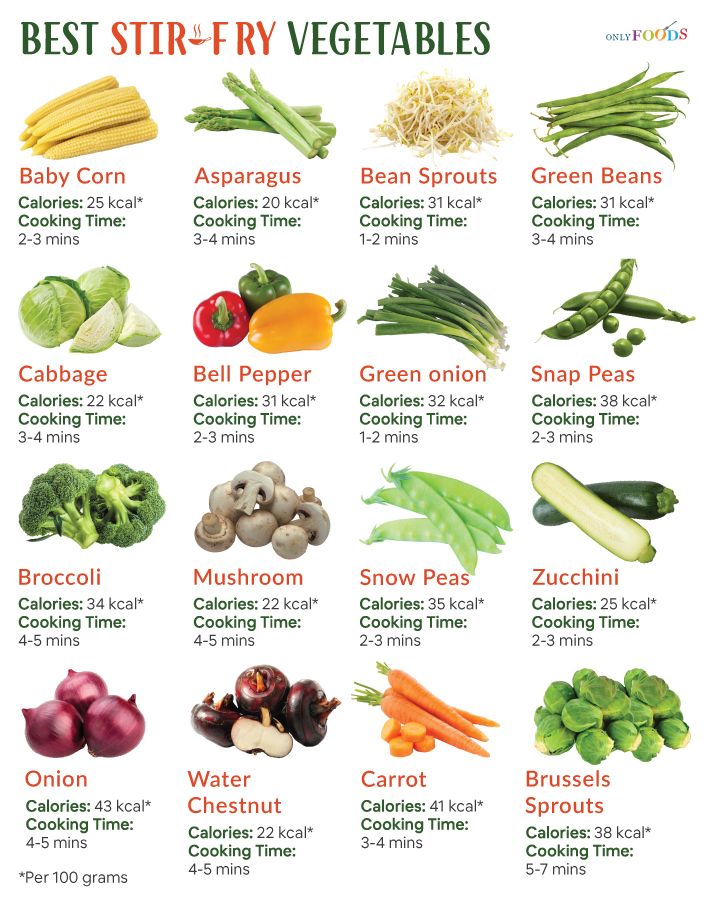Best Vegetables to Add to a Stir-Fry
Stir-frying is a cooking technique where vegetables can be cooked in minutes in a flat, wide pan over high heat. So, the vegetables become tender yet crisp, keeping their color, texture, and nutrient content intact. A traditional cooking method from China, stir-frying is almost the same as sautéing, except it needs higher heat, less time, and is done in a wok instead of a sauté pan.
The key to making a good stir-fry is avoiding overcooking the vegetables. To that end, you need to know the cooking times of each vegetable so you can put them in the wok in the correct order. Broccoli and Brussels sprouts are two vegetables that take the longest to cook. In contrast, bell peppers, peas, and spring onions take the least time.
List of the Best Vegetables That Go in a Stir-Fry
The following table includes the vegetables commonly used for the preparation with a basic idea about each one’s cooking time. It’s essential to keep track of the time to retain the color and crunch of your vegetables. Vegetable with the longest cooking time will go into the pan first. Don’t add baby corn before Brussels sprouts, or cook mushrooms longer than broccoli.
Stir-frying does not affect the caloric content of foods much; Knowing the calories in each vegetable helps you count the calories in your stir-fried dish.
| Name | Calories (per 100g cooked) | Cooking Time (approx.) |
|---|---|---|
| Broccoli | 34 kcal | 4-5 mins |
| Brussels Sprouts | 38 kcal | 5-7 mins |
| Onion (Red, white, yellow) | 43 kcal | 4-5 mins |
| Carrots | 41 kcal | 3-4 mins |
| Green Beans | 31 kcal | 3-4 mins |
| Mushrooms | 22 kcal | 4-5 mins |
| Bell Peppers (All colors) | 31 kcal | 2-3 mins |
| Snap Peas | 38 kcal | 2-3 mins |
| Snow Peas | 35 kcal | 2-3 mins |
| Baby Corn | 25 kcal | 2-3 mins |
| Water Chestnuts | 81 kcal | 2-3 mins |
| Cabbage (Napa or regular) | 22 kcal | 3-4 mins |
| Asparagus | 20 kcal | 3-4 mins |
| Green Onion | 32 kcal | 1-2 mins |
| Zucchini | 25 kcal | 2-3 mins |
| Bean Sprouts | 31 kcal | 1-2 mins |
Ginger and garlic are almost always added to stir-fries. Still, despite technically being vegetables, they aren’t counted as such in the preparation because their use is mainly as a flavoring agent. Freshly chopped ginger and garlic are added directly to the wok at the beginning of cooking.
Leafy greens like spinach and bok choy can also be added, but some people find them to become too soft and soggy when stir-fried. Adding them to the pan just about a minute before turning off the heat helps hold their texture and color.
Get the Most Out of Your Stir-Fry Vegetables
Prepping: Cutting all the vegetables into small bite-size pieces of similar size helps them to cook evenly.
Choosing the Pan: There is a reason the wok or skillet is the preferred utensil for stir-frying. The wider surface area allows enough space for any extra moisture from the vegetables to evaporate quickly. Otherwise, the vegetables would get steamed and soupy instead of fried.
You can serve stir-fried vegetables on their own or on top of some noodles or rice. They also go well with ramen and zoodles.
Are There Any Vegetables to Avoid?
Just as the vegetables in the above list are best in a stir-fry, there are a few that you would do better to steer clear of. Tomatoes are at the top of this list, with their high water content that can ruin the whole preparation. Then, there are potatoes and squashes with a dense texture unsuitable for stir-frying. They can easily turn mushy when added to the wok with the other vegetables.
FAQ
As mentioned above, stir-frying doesn’t significantly affect the calories in the vegetables. Additionally, it can actually help the body better absorb some plant-derived nutrients and fat-soluble vitamins. The only nutrient loss is of the water-soluble vitamin C. Still, studies show this loss to be much less significant than in other cooking methods like stir-frying and then boiling or just boiling.
Freezing can change the texture of vegetables, especially those with a higher water content, like broccoli. So, stir-frying frozen vegetables is not the same as making them fresh. Still, they are incredibly convenient, and the results are good enough.
The typical way is to take the frozen vegetables out of the freezer and throwing them directly into the pan – without thawing. However, many people find it difficult to keep their vegetables from too watery and soggy. So, some suggest microwaving the vegetables, or thawing and drying them before adding them to the wok.

